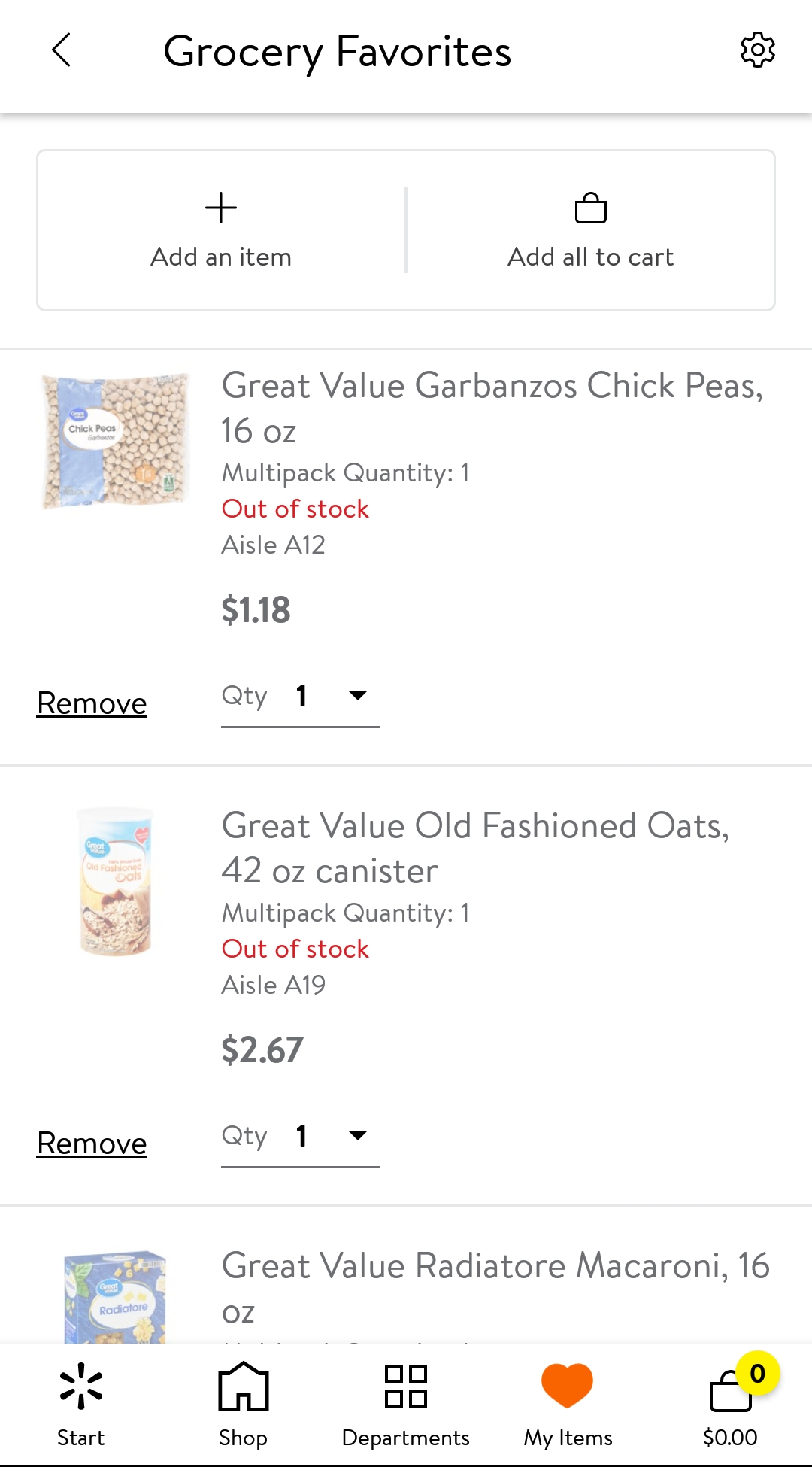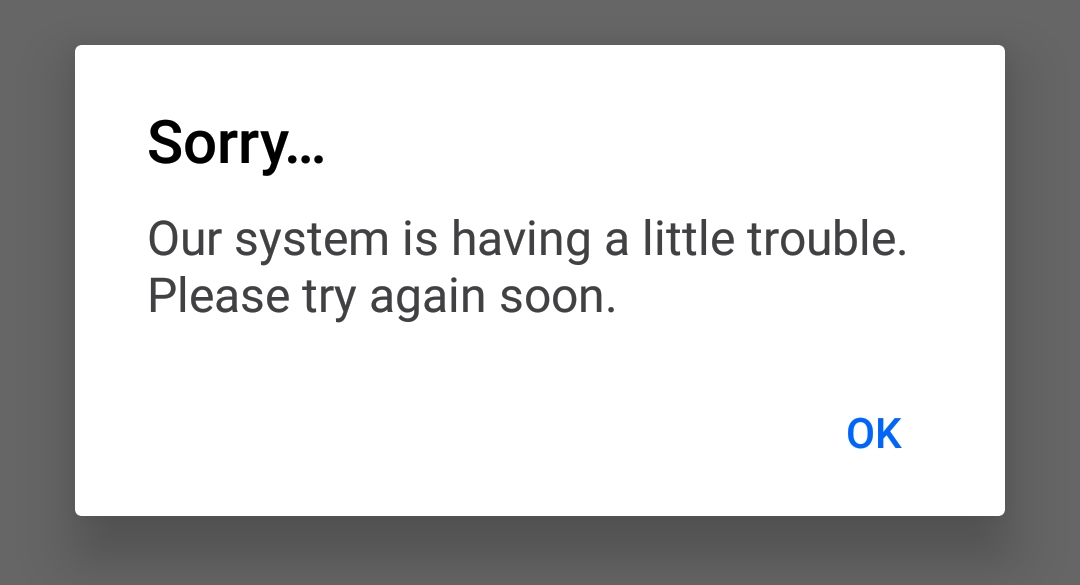How I'd Improve Walmart's Curbside Pricing Page
Monday, October 12, 2020
What is Walmart's curbside pickup?
Given the constant discussion of Covid-19, it's not surprising that people are trying to avoid contact with strangers. Many shoppers see Walmart's curbside pickup as a means of acquiring food without coming into proximity with others.
Here's how the curbside pickup works:
- The shopper logs into Walmart's website or smartphone app
- The shopper selects some products to buy
- The shopper pays for his selected products
- The shopper drives to his local store
- A worker loads up the shopper's car with his purchases
You might think because the process is so simple, there would be little room for improvement. To the contrary, I've discovered several opportunities on the Android app's ordering screen that have the potential to increase Walmart's profits and to provide it with a very strong strategic advantage over other retailers.
What happened when I tried to make a purchase?
I selected a few of my favorited items and attempted to purchase them with my Android phone. It was then that I discovered that several items including a bag of chickpeas were listed as out of stock.

It soon became clear that Walmart's implementation could be improved upon in three ways.
Barrier to purchase removal
My DUMB model of pricing power considers any barriers to a shopper's purchase to be a very bad thing. With few exceptions, when a buyer is willing and able to pay full price for a given product, businesses should endeavor to make his shopping experience as seamless and streamlined as possible. Even the slightest hiccup could mean the difference between a profitable sale and a costly increase in inventory turnover time, leading to reduced profitability and a reduction in cash flow.
I was the very definition of an ideal shopper. I had my credit card in hand, eager to make a purchase, and was stopped by an error message: my desired chickpeas were out of stock. Devastated, I found it hard to believe that such a massive corporation didn't have any chickpeas in stock somewhere. Out of curiosity, I checked the website to see if it was available for delivery rather than pickup. To my astonishment, there were plenty of bags of chickpeas that could be delivered straight to my door.
Wouldn't it have been great for the app to notify me that the object of my desire was available for delivery? Since the majority of my curbside order consisted of perishables which were not available for delivery, an intelligent software system would have realized that my ordering chickpeas for delivery would have provided Walmart with an enormous opportunity for additional revenue. After all, the free delivery touted on the website requires a minimum order size of $35. If I were to order chickpeas for delivery, I'd either have to order a lot of them or add on a significant quantity of other items that I hadn't even consider buying just five minutes previously.
I'll be the first to admit that there may be some manner of principal-agent issues in the mix, with different teams at Walmart being credited with curbside purchases vs. delivery purchases. Nevertheless, I'm sure that such matters could be dealt with by tracking how each purchase was initiated. Even if this issue proved too politically contentious to tackle internally, a programmer could probably add a notification system to alert me when my chickpeas were restocked. In fact, most marketers would give an arm and a leg for a legitimate method for contacting shoppers who are ready to make a purchase.
By simply telling buyers that they can't make a given purchase, several undesirable outcomes may result:
- Willing buyers might keep checking the inventory and become increasingly irritated and dissatisfied upon each refresh
- Willing buyers might become fatigued and buy elsewhere
- Willing buyers might give up and forgo their purchase entirely (aka the missing option)
Substitute offerings
Unlike salt, chickpeas really are a commodity. If I were to set up a chickpea version of the Pepsi Challenge, I doubt anyone would be able to tell the difference between one brand's selection of chickpeas and another's. Even on the off-chance that a buyer was completely loyal to a given label, I suspect that he would be open to other sizes of chickpea bags.
Rather than providing any suggestions of other labels or sizes, however, Walmart simply informed me that I was out of luck. As a result, the company missed out on a potential sale. How hard would it have been to provide a substitute offering? Walmart could have even suggested a more expensive alternative from a premium brand like Goya. Convincing a desperate buyer to purchase a more expensive substitute is as close to free money as most companies can ever hope to come.
In the spirit of complete transparency, I should point out that the website treated me far better in this respect. The order page noted that my selection of chickpeas could not be filled and presented me with a find similar button.

Although an improvement, even this implementation had several shortcomings:
- The website required me to take the proactive action of clicking a button and required me to use my brain power to select the appropriate replacement. Businesses should take note: increasing customer responsibility and need for action generally decreases customer spending and proclivity to make purchases.
- Far more egregious, however, was that not one of the substitutes was chickpeas at all. I've worked on recommendation systems, and I know they can be incredibly challenging to implement. That said, for a commodity offering like chickpeas, with a name that consists solely of Walmart's own brand and the two genericized names for the product, I would expect a strong set of results. True, chickpeas are sometimes referred to by other names, such as garbanzo beans, Egyptian peas, or gram, but the logic behind some of the suggestions appeared tenuous at best. What would Gordon Ramsay say if I tried to swap out chickpeas for pinto beans or a mango drink?

Do these look like good substitutes? 
How about these? - Most concerning of all, was that when I accepted the first suggestion (Edamame), it removed my favorited bag of chickpeas from my bookmarked items. Given that Edamame is not, by any measure, a close substitute for chickpeas, Walmart is effectively reducing its stickiness. In an extreme case, a customer might find his entire list of favorited items completely removed from the system and, with the prospect of searching for and re-adding each ahead of him, choose to go through the process with another retailer.
Additional locations
When I first set up the Android application, I selected the Walmart store that I thought was closest to my home. Truth be told, there are about half a dozen Walmarts in very close proximity to my residence. Any one of them would have been within a quick and easy drive. Isn't it strange that the app didn't check to see if any of those other stores had chickpeas in stock? If a shopper desperately wanted an item that wasn't available at his local store, is it so unimaginable that he'd be willing to travel a mile or two out of his way to obtain it elsewhere? Given that the app knows my location, my desired products, and the inventory of each and every one of its locations, it probably wouldn't be all that difficult to let me know if I could pick up my order elsewhere.
This functionality wouldn't just be a matter of increasing sales. It could also become a potential goldmine of very valuable and very difficult to obtain customer data. Walmart could measure shoppers' price sensitivities and brand loyalties by calculating how far shoppers are willing to travel in order to pick up their items elsewhere.
While I can't speak to Walmart specifically, it has long been reported that supermarkets earn an approximate 1% margin on sales. Acquiring data that could be used to increase revenues per product by a measly 0.1% would wind up increasing total profits by a whopping 10%. The outsized effect that seemingly small changes can have on business profitability is the very reason why companies spend billions on ideas that many consumers would find downright wacky. It's hard to argue that shoppers who are willing to go well out of their way for specific items (and pay the costs of their vehicle fuel consumption) would even care about a tiny increase in markup.
Bonus problem
Although not pricing related, I found another problem too. In order to log into the website, I had to reset my password. This reset apparently disabled my ability to use the Android application. The only indication that I received as a result was a pair of unmatched yet generic error messages that made no mention of my password.


Further, I saw no obvious means of resetting my login credentials. I can only imagine how frustrating such a problem would be for a non-technical person to debug. Many customers would likely uninstall the app in frustration and take their business elsewhere. As a general rule, any failed attempt to authenticate should result in a prompt to reset the user's login information.
Conclusion
Although I have no doubt that many people worked very hard to design Walmart's curbside process and that many shoppers enjoy using it, there is plenty of room for improvement. Even relatively small changes have the potential to provide Walmart with significant value - both in terms of increased profits and increased insight into its pricing power.
- Walmart: if you're listening, I'd be happy to help. Just let me know when I can finally pick up my chickpeas.
- Everyone else: If I can find low-hanging fruit on the pricing page of the #1 company on the Fortune 500, imagine what I could do for your business.
Either way, contact me to find out how I can help increase your profits.